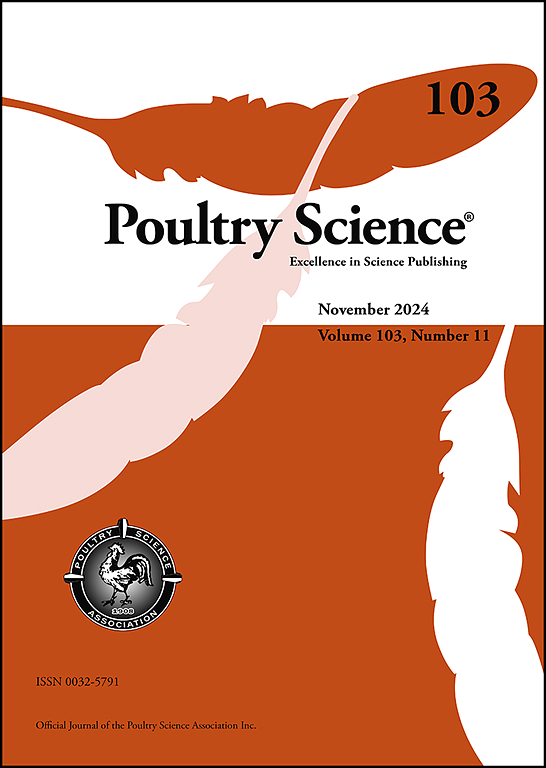LncRNA A2ml2 inhibits fatty liver hemorrhage syndrome progression and function as ceRNA to target LPL by sponging miR-143-5p
IF 3.8
1区 农林科学
Q1 AGRICULTURE, DAIRY & ANIMAL SCIENCE
引用次数: 0
Abstract
Fatty liver hemorrhage syndrome (FLHS) is the most common metabolic diseases in laying hens during the late-laying period, and it causes a significant economic burden on the poultry industry. The competing endogenous RNA plays crucial roles in the occurrence and development of fatty liver. Based on the previously constructed lncRNA-miRNA-mRNA networks, we selected the axis of ENSGALT00000079786-LPL-miR-143-5p for further study to elucidate its mechanistic role in development of fatty liver. In this study, we identified a novel highly conserved lncRNA (ENSGALT00000079786) in poultry, which we designated as lncRNA A2ml2 based on its chromosomal location. Fluorescent in situ hybridization (FISH) revealed that lncRNA A2ml2 was localized in both the nucleus and cytoplasm. Dual-luciferase reporter assay validated the targeted relationship between lncRNA A2ml2, miR-143-5p, and the LPL gene. To further analyze the lncRNA A2ml2 and miR-143-5p function, lncRNA A2ml2 overexpression vector was successfully constructed and transfected into Leghorn male hepatocellular (LMH) cells, which could remarkably inhibit cellular lipid deposition was detected by oil red staining (P < 0.01), the opposite occurred for miR-143-5p (P < 0.01). qPCR demonstrated an inverse correlation between miR-143-5p expression and lncRNA A2ml2 expression, and confirmed that miR-143-5p directly target lncRNA A2ml2. Similarly, we found an inverse correlation between expression of LPL and the expression of miR-143-5p. To further investigate the interactions among these three factors and their effects on cellular lipid metabolism, we assessed the expression levels of LPL by co-transfecting lncRNA A2ml2 with miR-143-5p mimic and miR-143-5p mimic binding site mutants. Co-transfection experiments showed that miR-143-5p diminished the promoting effect of lncRNA A2ml2 on LPL. Meanwhile, miR-143-5p has the capacity to mitigate the suppressive impact of lncRNA A2ml2 overexpression on lipid accumulation in LMH cells. The results revealed that lncRNA A2ml2 attenuated hepatic lipid accumulation through negatively regulating miR-143-5p and enhancing LPL expression in LMH cells. Our findings offer novel insights into ceRNA-mediated in FLHS and identify a novel lncRNA as a potential molecular biomarker.
脂肪肝出血综合征(FLHS)是蛋鸡产蛋后期最常见的代谢性疾病,给家禽业造成了巨大的经济负担。竞争性内源 RNA 在脂肪肝的发生和发展中起着至关重要的作用。基于之前构建的lncRNA-miRNA-mRNA网络,我们选择了ENSGALT00000079786-LPL-miR-143-5p轴作为进一步研究的对象,以阐明其在脂肪肝发生发展中的机理作用。在这项研究中,我们在家禽中发现了一个新的高度保守的lncRNA(ENSGALT00000079786),根据其染色体位置,我们将其命名为lncRNA A2ml2。荧光原位杂交(FISH)显示,lncRNA A2ml2定位于细胞核和细胞质中。双荧光素酶报告实验验证了 lncRNA A2ml2、miR-143-5p 和 LPL 基因之间的靶向关系。为了进一步分析lncRNA A2ml2和miR-143-5p的功能,我们成功地构建了lncRNA A2ml2过表达载体,并将其转染到Leghorn雄性肝细胞(LMH)细胞中,通过油红染色检测发现,lncRNA A2ml2能显著抑制细胞脂质沉积(P < 0.qPCR表明miR-143-5p的表达与lncRNA A2ml2的表达呈反相关,证实miR-143-5p直接靶向lncRNA A2ml2。同样,我们还发现 LPL 的表达与 miR-143-5p 的表达呈反相关。为了进一步研究这三个因子之间的相互作用及其对细胞脂质代谢的影响,我们通过将lncRNA A2ml2与miR-143-5p模拟物和miR-143-5p模拟物结合位点突变体共转染来评估LPL的表达水平。共转染实验表明,miR-143-5p削弱了lncRNA A2ml2对LPL的促进作用。同时,miR-143-5p还能减轻lncRNA A2ml2过表达对LMH细胞脂质积累的抑制作用。研究结果表明,lncRNA A2ml2通过负调控miR-143-5p和增强LMH细胞中LPL的表达来减轻肝脏脂质积累。我们的研究结果为ceRNA介导的FLHS提供了新的见解,并确定了一种新型lncRNA作为潜在的分子生物标志物。
本文章由计算机程序翻译,如有差异,请以英文原文为准。
求助全文
约1分钟内获得全文
求助全文
来源期刊

Poultry Science
农林科学-奶制品与动物科学
CiteScore
7.60
自引率
15.90%
发文量
0
审稿时长
94 days
期刊介绍:
First self-published in 1921, Poultry Science is an internationally renowned monthly journal, known as the authoritative source for a broad range of poultry information and high-caliber research. The journal plays a pivotal role in the dissemination of preeminent poultry-related knowledge across all disciplines. As of January 2020, Poultry Science will become an Open Access journal with no subscription charges, meaning authors who publish here can make their research immediately, permanently, and freely accessible worldwide while retaining copyright to their work. Papers submitted for publication after October 1, 2019 will be published as Open Access papers.
An international journal, Poultry Science publishes original papers, research notes, symposium papers, and reviews of basic science as applied to poultry. This authoritative source of poultry information is consistently ranked by ISI Impact Factor as one of the top 10 agriculture, dairy and animal science journals to deliver high-caliber research. Currently it is the highest-ranked (by Impact Factor and Eigenfactor) journal dedicated to publishing poultry research. Subject areas include breeding, genetics, education, production, management, environment, health, behavior, welfare, immunology, molecular biology, metabolism, nutrition, physiology, reproduction, processing, and products.
 求助内容:
求助内容: 应助结果提醒方式:
应助结果提醒方式:


